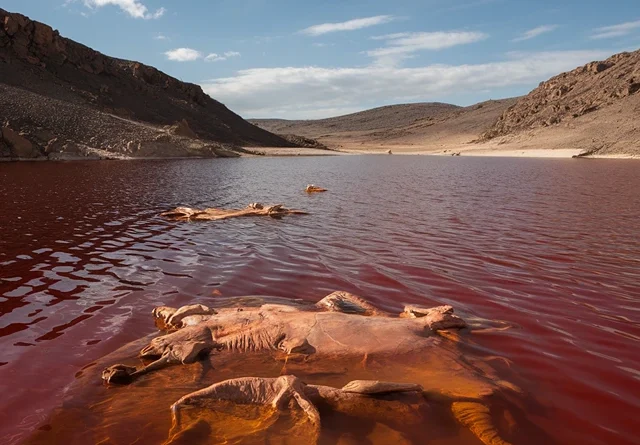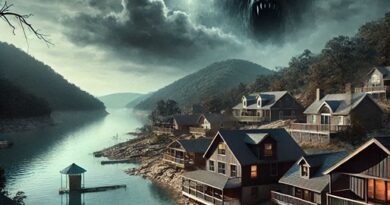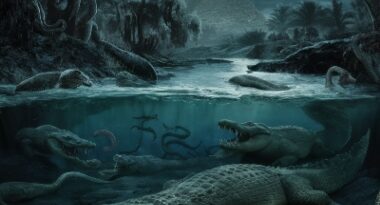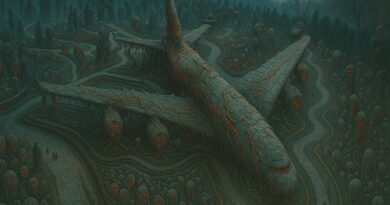Lake Natron: A Red Lake That Turns Animals Into Stone (Sort Of)
Some terms take us back many, many years. For example, “Fossilized Animals” refers to the remains, molds, or tracks of ancient animals (usually at least 10,000 years old) preserved on Earth, often after their hard parts were buried in sediments. Lake Natron in Tanzania is changing the rules, and thanks to its unique composition, it can quickly turn unfortunate animals that come to it as hard as a stone. Let’s get to know “The Stone Lake,” which creates a Pet Cemetery in real life.
Let’s meet a super scary natural place, some considered the deadliest on earth.
Where Is Lake Natron Located?
Natron is a salt lake in northern Tanzania, near its border with Kenya and the East African Rift (EAR). The lake, which forms part of the country’s Northern Safari Circuit, is fed mainly by the waters of the Southern Ewaso Ng’iro River in Kenya and nearby mineral-rich hot springs.
If you examine its physical characteristics, you discover nothing special (although it is stunning). Lake Natron In Tanzania is about 65 kilometers long, its width varies according to water evaporation and the amount of rainfall in the season, and its area is a little over 1,000 km. There are countless deeper lakes, with Lake Natron’s depth reaching “only” up to three meters.
A Lake That Turns Animals Into Stone? Not Precisely, But Close
What made Lake Natron famous is that animals that come to it can become fossils shortly after contact with the water. If you will, it is just like in the well-known Greek myth about the monstrous female figure Medusa, who turns anyone who looks at her directly into stone, only in reality.
It is important to note that, contrary to one of the accepted perceptions, the animals do not die and turn into stone due to contact with the water. It is more accurate to say that they died in the water for various reasons and that their carcasses were then well preserved by the salts and chemicals in the water, which turns the animals into a kind of salty statue.
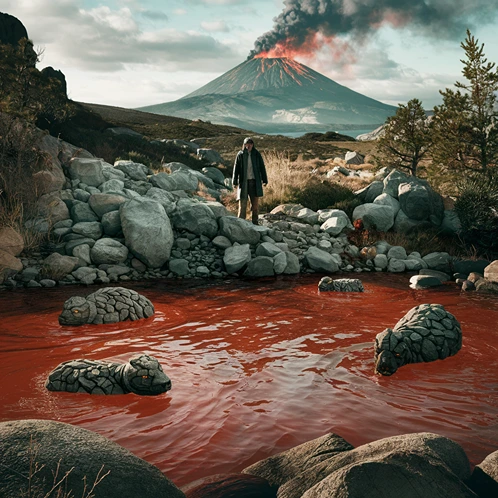
The Creation Of Lake Natron Stone Animals
To understand why this happens, it is crucial to see the composition of the water in the lake. First, near the lake rises the Ol Doinyo Langai (“Mountain of God”) volcano, the only active in northern Tanzania, which rises to a height of about 2,962 meters. Ol Doinyo Lengai is the only active volcano in the world producing carbonatite lava – a rare type of lava with high amounts of carbonate minerals, sodium, and potassium. The volcanic rocks in the area “contribute” to the extreme chemical composition of the water in the lake, which is rich in substances such as sodium carbonate and sodium bicarbonate.
As a result of all this, the water in the lake can also reach about 40-60 degrees Celsius at a high alkalinity level (between 9 and 10.5 pH, so that a strong base is created rather than an acid), which is more reminiscent of ammonia. When the water evaporates – which happens at an extremely high rate – it leaves behind a mixture of salts and minerals called Natron, which gave the lake its name.
Why Is Lake Natron Red? (Spoiler: It’s Not Blood)
One of Lake Natron’s nicknames is “Deadly Red Lake,” a term that refers to the reddish color of its water. As in the case of the Blood Falls in Antarctica, which we wrote about here not long ago, the composition of the water is what defines their color.
In the case of Lake Natron, the reason for this color is also related to its extreme alkalinity. When it is exceptionally high, ideal conditions are created in the area to grow various microorganisms, including algae and bacteria attracted to salt water. The amounts of salt and the high pH levels of the lake cause these microorganisms to thrive even more.
One of the central “residents” in Lake Natron is the Haloarchae, some Prokaryotic Archaea known for its red pigmentation. It’s what gives the water its unique and rather scary color.
Is Lake Natron Dangerous?
On the surface, Lake Natron in Tanzania looks very tempting, with its shiny, emerald waters, which sometimes blend perfectly with the sky. That is when the water is not red in a more reminiscent way of blood.
The problem is that the unique composition of the water, its level of alkalinity, the high temperature, and the other parameters we mentioned earlier mean that anyone who comes into contact with it may undergo a hardening process, to which the various substances “contribute.”
Sodium carbonate, for example, is a preservative used by the Egyptians for embalming purposes. As we mentioned earlier, the water won’t kill the animals, but it can cause calcification and hardening of those who get there and die.
Can You Swim In Lake Natrom?
The fact that the water here is caustic causes several other possible effects that are far from pleasant. People who have come here have reported severe symptoms such as burns, skin and eye irritation, or blurred vision. An example of this is wildlife photographers who boarded a helicopter in 2007 to admire the impressive panoramic views of the area. However, the helicopter flew too close to the terrain and crashed. All nine crew members survived and were rescued with relatively minor injuries, such as broken legs, but some reported symptoms, such as severe eye burns and blurred vision.
Fortunately, there are no known human deaths from Lake Natron. Still, there is no doubt that this is a place you should stay away from and definitely not swim in the water. The lake attracts mainly scientists or photographers, and it is easy to understand why.
Here is an example of a video with the amusing title “How to Survive Lake Natron”:
The lake gained fame a little over a decade ago after British photographer Nick Brandt published a gallery of breathtaking photos he took there. Brandt published the photos as part of his book, “Across the Ravaged Land,” a term referring to the fact that he works a lot for animals and the preservation of the ecosystem in Africa.
Brandt did “stage” some of the photos – that is, he took the animals out of the water and put them in different poses, in some cases in a way that would simulate a situation in which they were alive. But even so, it is difficult to ignore the breathtaking beauty of the lake and the phenomenon that manages to be mesmerizing, fascinating, and sad simultaneously. “I unexpectedly found the creatures — all manner of birds and bats — washed up along the shoreline of Lake Natron in Northern Tanzania. I could not help but photograph them,” he said. “No one knows for certain exactly how they die, but it appears that the extreme reflective nature of the lake’s surface confuses them, and like birds crashing into plate glass windows, they crash into the lake.”
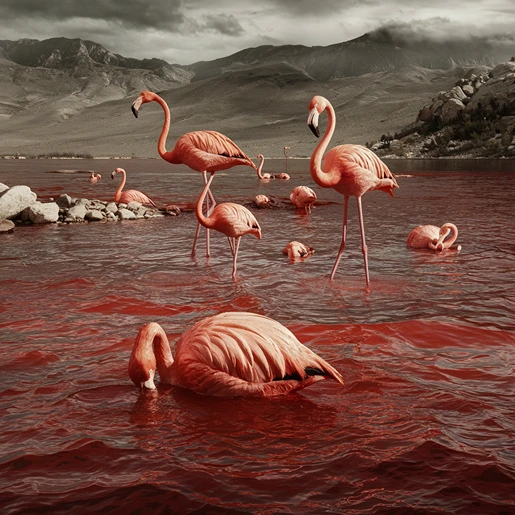
The Animals Of Lake Natron: A Heaven For Flamingos?
The bottom line is that the lake’s high temperatures and alkalinity make it very difficult for animals and plants that want to thrive here. After all, the lake is part of an ecosystem of salt and freshwater marshes.
However, some birds, fish, and microorganisms, such as different types of flamingos, tilapia, and algae, can handle the lake’s extreme conditions and have learned to adapt to them. In fact, the birds benefit from the algae that live here, on the one hand, and from the fact that the lake does not attract predators on the other, which, somewhat ironically, makes it safe for them to stay there.
The lake is home to about 2.5 million flamingos, creating one of the largest concentrations of these magnificent birds in eastern Africa. The fact that flamingos can survive here is primarily due to their physical characteristics. These birds are known for their tough skin, scales on their feet that prevent burns, and glands on their heads that help remove salt from the water and drain it from the body.
Can You Visit Lake Natron?
Note that, unlike some of the world’s other terrifying natural sites, Lake Natron is not currently designated as a national park but a site of great ecological and geological importance. The lake and surrounding area are somewhat protected, with conservation efforts focused on protecting the lake’s environmental conditions and the habitats of the animals that have made it their home.
You can visit here – preferably as part of tours, organized day trips, or even multi-day camping trips – but following the rules is essential. You already know what happened to Lot’s wife or those who look directly at Medusa in Greek mythology, right?

